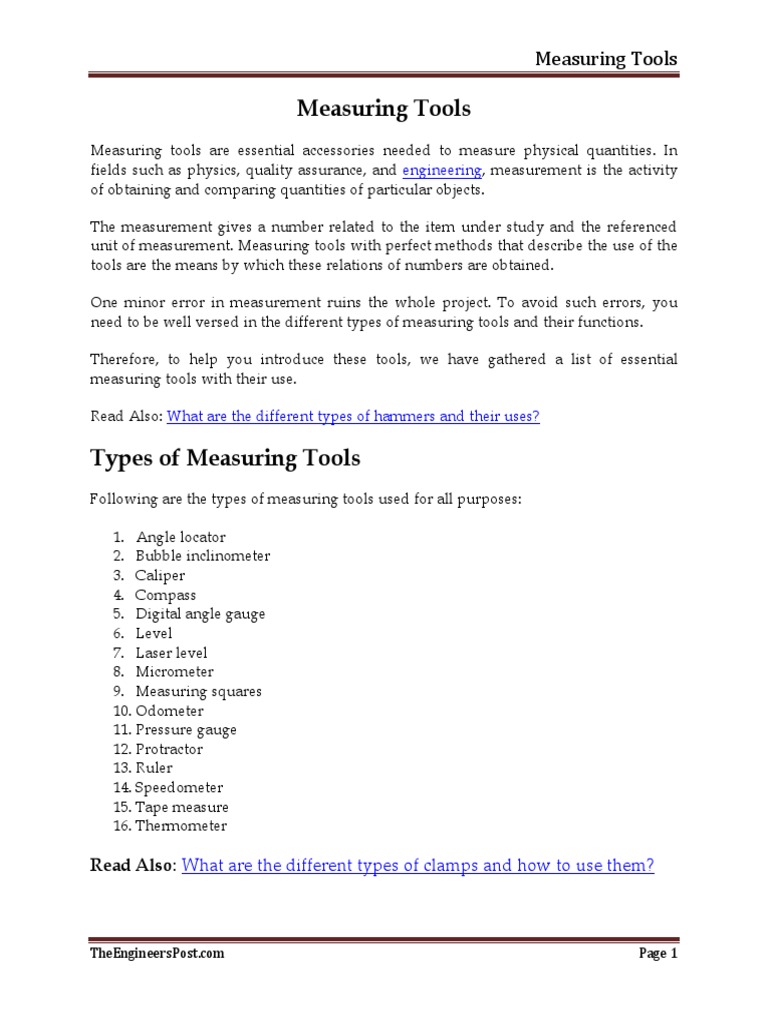Measuring tools are indispensable instruments in the realm of science, engineering, and everyday life. They serve a fundamental purpose: to quantify physical quantities, be it length, mass, volume, temperature, or other measurable attributes. By doing so, measuring tools bridge the chasm between abstract concepts and tangible realities, conferring precision upon our understanding and manipulation of the world around us. This treatise delves into the essence, types, applications, and implications of measuring tools, cultivating a deeper appreciation for their pivotal role in empirical inquiry and technological advancement.
To comprehend the full scope of measuring tools, one must first consider their etymological roots. The term “measure” derives from the Latin “mensura,” which connotes the act of evaluating dimensions. This notion is closely tied to a plethora of disciplines, where quantification becomes the linchpin of accuracy and reliability. In essence, measuring tools are extensions of our senses, augmented by mathematical principles and scientific theories that enable us to discern characteristics that would otherwise remain elusive.
One might categorize measuring tools into several distinct categories based on their application and measurement type. Linear measuring tools, such as rulers and calipers, are ubiquitous in both academic and domestic contexts. They provide a straightforward means of ascertaining dimensions with an impressive degree of accuracy. Conversely, volumetric measuring tools, including graduated cylinders and pipettes, are essential in the fields of chemistry and biology. These instruments allow researchers to accurately dispense and mix substances, thereby ensuring reproducibility and reliability in experimental results.
Temperature measurement introduces a fascinating dimension to the discourse on measuring tools. Thermometers, whether mercurial or digital, facilitate the exploration of thermal dynamics and are vital in various scientific domains—from meteorology to thermodynamics. The advent of infrared thermometers has further revolutionized temperature measurement by enabling remote assessment, thereby enhancing safety and convenience.
Another category worthy of examination is the realm of mass measurement. Scales and balances perform this function with finesse, differentiating between two primary methodologies: the comparison of an unknown mass against a known standard and the utilization of gravitational forces on an object. The latter, as exemplified by a digital scale, is ubiquitous in commercial and laboratory settings, where precision can be paramount.
The advent of technological advancements has transformed traditional measuring tools into sophisticated instruments of precision. For instance, laser distance measurers have rendered conventional tape measures nearly obsolete in various professional fields. These devices utilize the principles of laser physics to produce measurements with unprecedented accuracy, thereby introducing a paradigm shift in architecture, construction, and surveying.
Moreover, measuring tools are not limited to material quantification; they also extend into the domain of abstract phenomena. Psychometrics, for instance, employs measuring tools to quantify cognitive and emotional attributes, serving as an essential component in educational assessments and psychological evaluations. This innovative approach illustrates how measuring tools transcend physical dimensions and penetrate the complexities of human behavior.
In addition to their practical applications, measuring tools provoke critical reflections on the philosophies underlying measurement itself. The question of accuracy versus precision becomes paramount. Accuracy refers to how close a measurement is to the true value, while precision indicates the repeatability or consistency of measurements. This nuanced distinction compels physicists and engineers to grapple with uncertainty and error—challenges that can significantly impact experimental conclusions and technological innovation.
The implications of employing measuring tools extend beyond the siren call of empirical accuracy; they also encompass ethical considerations. The potential misuse of measuring tools, especially in contexts such as medical diagnostics and environmental monitoring, invites scrutiny regarding their calibration, maintenance, and the integrity of the data produced. This dimension brings forth discussions about accountability and the ramifications of erroneous measurements on societal well-being.
Furthermore, the cultural significance of measuring tools warrants examination. Across different societies and historical periods, various civilizations have developed unique instruments to serve their specific measurement needs—be it the ancient Egyptians’ use of cubits for monumental architecture or the intricate astronomical measuring devices crafted by Renaissance polymaths. Each tool reflects the epistemic priorities of its time, thereby serving as an artifact of intellectual thought and cultural evolution.
With the proliferation of digital technology, we now find ourselves at a crossroads: where tradition meets innovation. The integration of artificial intelligence in measuring tools promises to enhance both accuracy and user engagement. Smart measuring tools equipped with connectivity features will likely revolutionize data collection and analysis, leading to a more integrated approach to scientific inquiry.
In conclusion, measuring tools are not mere instruments; they are intellectual scaffolds that support our quest for knowledge and understanding. They facilitate the articulation of relationships between measurable phenomena, laying the groundwork for advancements across disciplines. As we continue to navigate the intricacies of the physical universe, the significance of these tools, both historical and contemporary, cannot be overstated. Their evolution not only reflects technological progress but also invites us to reconsider our relationship with quantification and the very nature of reality itself. As curiosity is piqued and perspectives shift, one might ask: what new dimensions of understanding await us through the lens of measuring tools?










